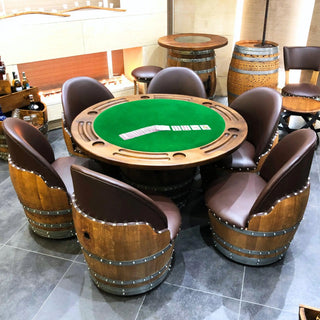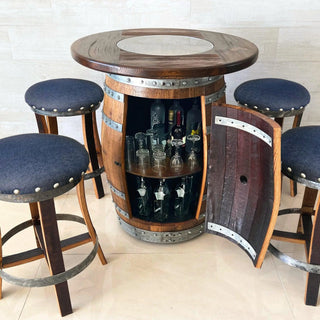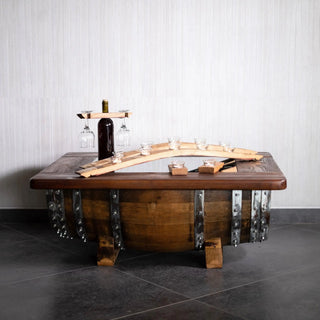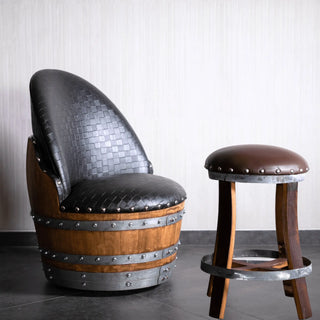5 Common Barrel Problems (and How to Fix Them Before It’s Too Late)
You know that oak barrel you fell in love with—the one that smells faintly of old wine and has that deep, warm color that just feels like history? Maybe it’s sitting proudly on your patio or next to your home bar right now. It’s gorgeous, but let’s be honest: time, weather, and gravity have a way of testing even the strongest oak.
One day you run your hand across the surface and notice… the metal hoop feels loose. There’s a small crack that wasn’t there last week. The color’s not quite as rich.
Relax. Don’t panic. Your barrel isn’t dying—it’s just asking for a little attention.
After years of restoring reclaimed oak barrels at Oak Wood Wine Barrels, I’ve seen it all—sun damage, loose staves, cracked hoops, warped bases, you name it. The good news? Almost every problem can be fixed at home with a few simple tricks.
So grab a cup of coffee—or a glass of Merlot if it’s that kind of day—and let’s talk about how to keep your barrel looking beautiful for years to come.
1. Loose Hoops — When Things Start to Wobble
Let’s start with the one that gets everyone nervous: the slipping hoop. You look over one day and notice that shiny metal band has sagged a little, or worse, started rattling. Suddenly your once-solid barrel feels like it’s falling apart.
What’s really happening:
Oak expands and contracts with humidity. When the air gets too dry, the wood shrinks ever so slightly, and the hoops lose their grip. It’s not poor craftsmanship—it’s just nature doing its thing.
The quick fix:
- Rehydrate the wood. Lightly mist the barrel with water, then wrap a damp towel around it overnight. By morning, the wood will have swelled just enough to snug those hoops back up.
- Tap the hoops back into place. Use a rubber mallet and a soft cloth to gently nudge the hoops upward. (Gently—no need to treat it like a drum solo.)
- Protect it with oil. Once everything feels firm again, wipe it down with a bit of furniture oil to lock in the moisture and prevent future shrinkage.
It’s honestly one of the most satisfying fixes—you can feel the barrel tighten back up as you work.
2. Cracked Staves — When the Oak Starts Whispering for Help
There’s a special kind of heartbreak that comes from spotting a crack in your barrel’s staves. But before you start mourning, take a deep breath. Small cracks are part of the aging process and can usually be fixed in an afternoon.
Why it happens:
Dry air and direct sunlight slowly pull moisture out of the wood until it splits. Think of it like chapped lips—but for oak.
How to fix it:
- For hairline cracks: Mix a little wood glue with fine sawdust and press it into the gap. Once it dries, sand it smooth and refinish the area.
- For deeper cracks: Use a wood filler that matches the oak tone, then refinish with your favorite stain or oil.
And if the crack is small and your barrel’s just decorative? Leave it. Sometimes that imperfection gives it even more personality. At Oak Wood Wine Barrels, we call that earned character.
3. Fading & Graying — When the Glow Disappears
You know that rich, golden tone oak barrels have? The kind that makes you think of wineries and warm sunsets? When that starts to fade into a dull gray, it’s a sign your barrel’s lost some of its protective finish.
Why it happens:
UV rays and moisture pull out the natural tannins in the wood. Over time, what was once honey-colored becomes weathered and pale.
How to fix it:
- Give it a light sanding. Use 120-grit sandpaper to remove the top layer of oxidized wood. Don’t go too deep—you just want to refresh the surface.
- Wipe it clean. A damp cloth will get rid of dust.
- Apply a finish that suits its home.
- Indoors? Use tung oil or Danish oil for a natural sheen.
- Outdoors? Go with marine varnish for UV and moisture protection.
- Buff it out once it’s dry and watch that color come rushing back.
I swear, seeing that deep amber hue return under your hands feels like reviving something sacred.
4. Wobbly Base — When Your Barrel Starts Dancing
Have you ever leaned on your barrel bar or table and felt it wobble just enough to make your drink nervous? That’s your cue to fix it before things go south.
Why it happens:
Oak staves can shift ever so slightly over time, or the bottom panel can warp from uneven moisture exposure.
How to fix it:
- Flip the barrel over and inspect the base. Look for any gaps or loose staves.
- Tighten any screws or fasteners if it’s been modified into furniture.
- For decorative barrels, a small amount of wood glue or epoxy in the gaps will re-stabilize the base.
- Want a pro trick? Add a circular support ring or baseboard under the barrel for balance—it’s invisible but makes a world of difference.
Once it’s steady again, you’ll feel the difference every time you lean on it—like it’s found its footing again.
5. Peeling or Flaky Finish — The “I’ve Been Neglected” Look
You can tell when a barrel hasn’t been pampered for a while. The finish starts peeling, it feels chalky to the touch, and the once-rich surface looks dry and dull. Don’t worry—it’s totally fixable (and kind of fun to fix).
Why it happens:
Sun, rain, and time. Every finish eventually breaks down, especially if the barrel sits outdoors.
How to fix it:
- Sand away the flaking. Use fine-grit sandpaper (around 220) to smooth it out.
- Clean off the dust. A quick wipe with a tack cloth does the trick.
- Refinish. Apply a coat of tung oil, polyurethane, or marine varnish, depending on where it lives.
- Let it dry completely before touching it. (Yes, waiting is the hardest part.)
Once it’s done, that dull, tired barrel will have a soft, buttery glow again. It’ll look loved. And honestly, that’s what good craftsmanship is about—care.
Bonus: How to Keep Barrel Problems from Happening at All
Most of these issues come down to neglect, not age. Here’s how to stay ahead:
- Keep your barrel out of direct sunlight whenever possible.
- Reapply oil or varnish every 6–12 months (it’s basically skincare for wood).
- Keep outdoor barrels slightly lifted off the ground—moisture underneath is a silent killer.
- Wipe them down occasionally to remove dirt and keep that finish healthy.
Little habits, big payoff. Barrels that get regular love don’t just last—they get better with age.
Our Links
- Learn more about barrel furniture restoration and care straight from our workshop.
- Explore our handcrafted oak barrel tables, bars, and décor made from real wine casks.
- Browse our premium oak finishes and protective coatings trusted by barrel enthusiasts everywhere.
Other Resources to Check Out!
- Fine Woodworking: The Art of Refinishing Oak Without Losing Its Soul
- The Cooper’s Journal: Traditional Wine Barrel Craft and Care
- Woodcraft Magazine: Choosing the Right Finish for Reclaimed Oak
Every time I fix up an old barrel, I can’t help but smile. There’s something almost poetic about it—reviving something that once held stories and spirits, giving it a new place in the world.
Barrels are like old friends: they might creak a little, but they’ve got heart. And when you take care of them, they stick around for decades.
So don’t wait for cracks or rust to get worse. Give that oak beauty some love today. Tighten it up, polish it, restore it—and watch it thank you by glowing again.
Disclaimer
This article is for informational and educational purposes only. The repair methods and tips shared here are based on real-world woodworking experience and are meant for decorative and furniture-grade barrels. Always use safety gear, work in a ventilated area, and test any product on a small surface first.
Oak Wood Wine Barrels assumes no responsibility for injuries, damages, or unintended results from DIY repair. Product finishes, materials, and care methods may evolve as our craftsmanship improves.
For professional restoration or to browse our line of fully restored oak and wine barrel furniture, visit OBARREL.COM — where every barrel gets a second chance, and every imperfection becomes part of its story.




